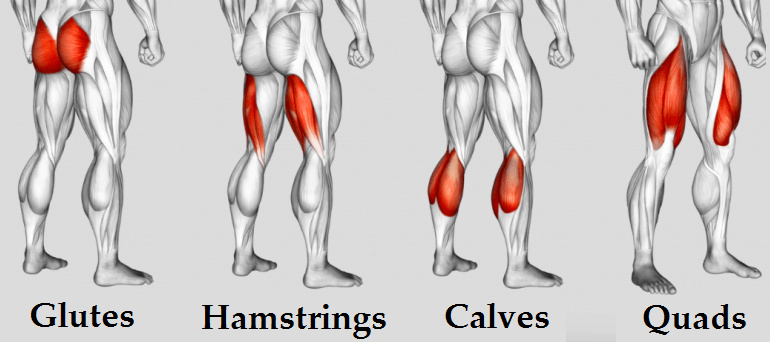Everyday is leg day! Read more if you want to learn about the science behind the most effective ways to grow and strengthen your legs. With the help of reputable athletes' experiences and scientists studying muscle development in the fitness field, I'll join you in your journey of healthy muscle growth and strength development.
Many people spend time focusing on the gimmicks of strength training. What type of shoes you have to wear, what supplements you take before or after, etc. While these things may add to your motivation and help get you to the gym, they're not going to make the biggest impact in your "gains."
The Basics
First, it's important to highlight the separate sections of the leg and the muscle group that we are trying to grow.

There are four main sections to keep in mind when training legs, all of which can be trained separately or more effectively- at the same time- with compound movements (like squats, deadlifts, and dumbbell lunges). For some science-based tips on growing your quads, check out this video by Jeremy Ethier.
But over time, your legs become accustomed to the repetitions and the weight, and an increase in either one is required to keep building strength.
Progressive Overload
That brings us to one of the most important aspects of muscle building. Simply put, progressive overload means doing more over time. This could mean adding more weight to the bar, or even something as easy as having more productive training sessions. This is crucial to keep your muscles challenged. By continuously increasing the demands of your muscles, you not only will make gains in strength and size, but also take huge strides in your bone and cardiovascular health.

While working hard at the gym is half the battle, recovery and nutrition are underrated in their impact on muscle growth and repair. Make sure you are eating enough calories to encourage muscle repair, but also enough protein (around 1-0.8 grams for every pound of body weight). Good recovery can be employed through simply having enough rest days, foam rolling, or electrical muscle stimulation. Anything that encourages blood circulation is going to aid muscle recovery because the increase blood flow helps flush out lactic acid, which is responsible for muscle soreness.
If you're on the lookout for an electrical muscle stimulation unit, we highly recommend the VPod. This wireless EMS/TENS/NMES Unit specializes in speeding up recovery with 24 different functions and customizable intensities. To learn more about the VPod and all it's benefits, visit VPod.Life.
VPOD Wireless TENS, EMS & NMES Unit

$149.00
$175.30
Pain sets limits. You deserve to be limitless. Our VPod Wireless TENS Unit is a lightweight, portable device that will provide natural pain relief for all of your aches and pains. Break the boundaries and live a limitless life with… read more
Happy Healing!

